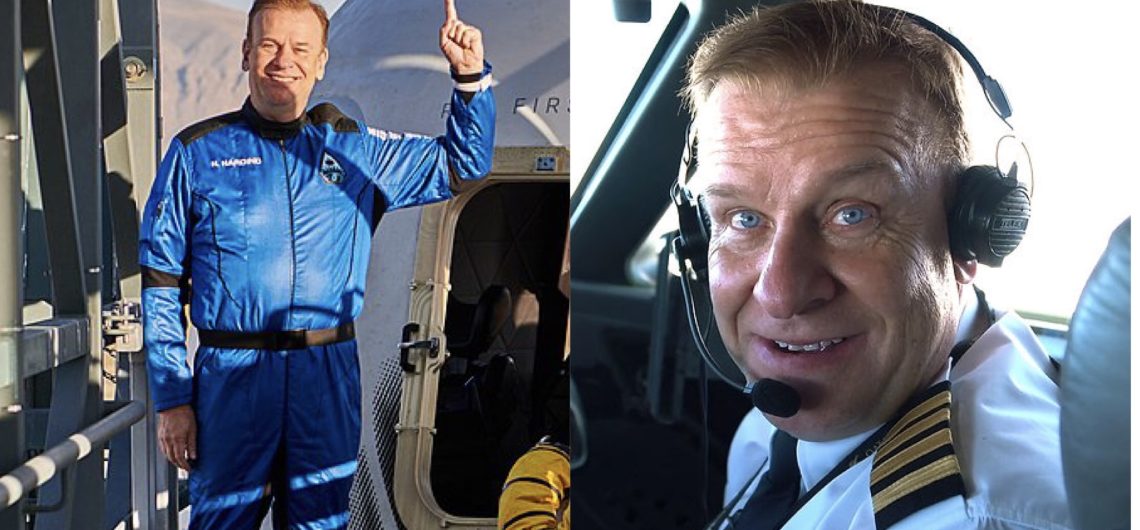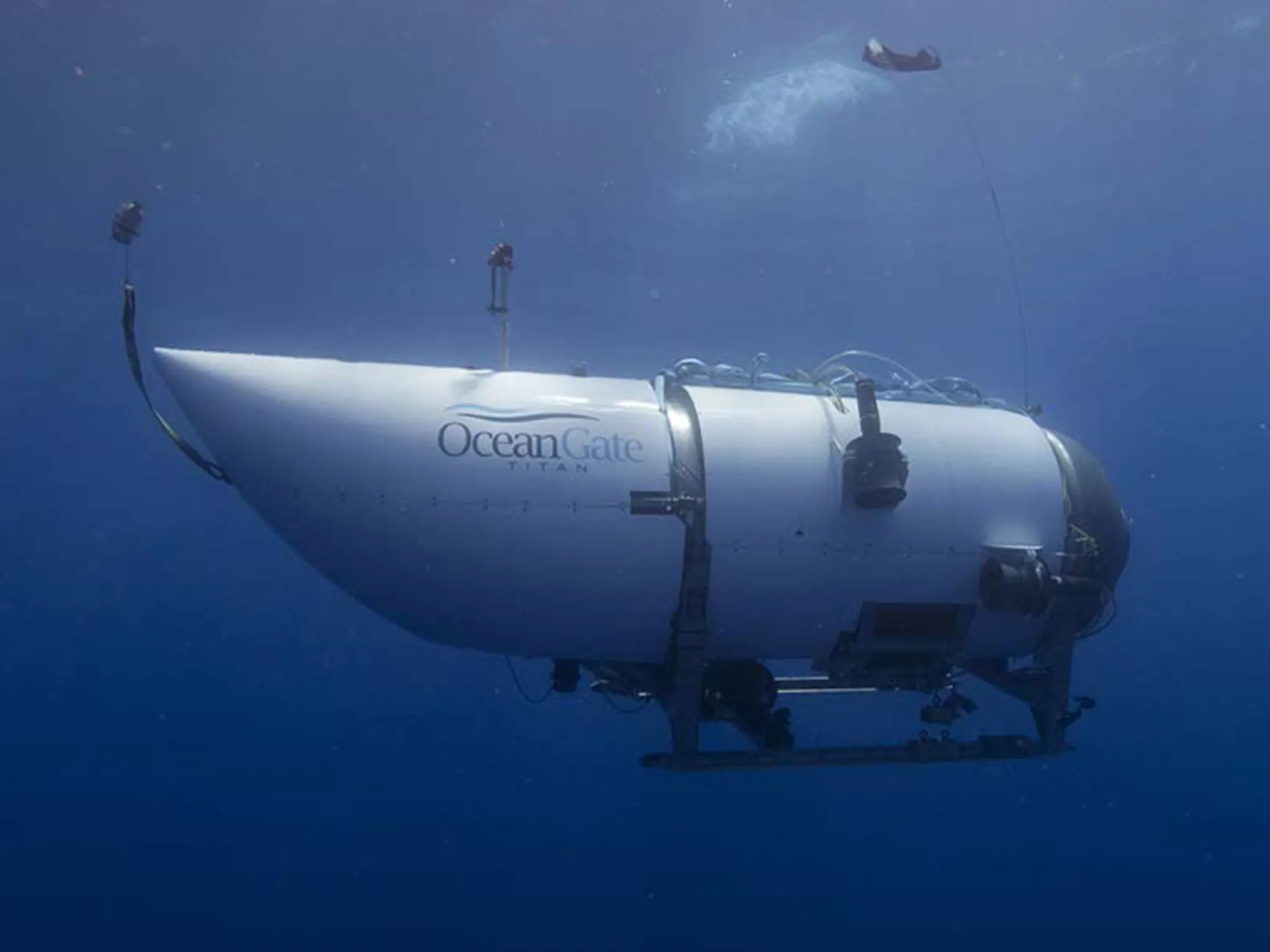British billionaire Hamish Harding, who is one of the five people who died at sea in an accident on a submersible dubbed Titan Sub by Oceangate traveling to see the wreckage of the Titanic, planned to climb Mount Kilimanjaro accompanied by his family and friends.
David Mearns, who is a friend of the late Harding, told Sky News that Hamish (58), who was the father of two children, planned to come to Tanzania to climb Mount Kilimanjaro in July this year, a trip he had planned for a long time but failed due to the corona epidemic.
Coast Guard officials have said that five large pieces of the vessel have been found while one of the dead in the accident is Stockton Rush, Founder and CEO of the OceanGate Company that owns the vessel.
‘They were both accomplished people’
David Mearns reflects on the lives and achievements of Hamish Harding and Paul-Henri Nargeolet currently missing on board the Titan submersible.
More here: https://t.co/7NP6ipEThi
📺 Sky 501, Virgin 602, Freeview 233 and YouTube pic.twitter.com/TpwNAMKAed
— Sky News (@SkyNews) June 22, 2023
All five on Titanic sub confirmed dead after ‘catastrophic’ implosion
All five passengers onboard a submersible that went missing near the Titanic’s wreckage died in an instant, according to the US Coast Guard, when their vehicle experienced a “catastrophic implosion” in the ocean depths.
The mournful decision marked the end of a global search-and-rescue mission that has gripped the globe since the tiny tourist ship went missing four days ago in the North Atlantic.
Rear Admiral John Mauger told reporters in Boston that the investigation revealed debris recovered on the bottom 1,600 feet (500 meters) from the Titanic’s bow was consistent with the sub’s pressure chamber implosion.
“On behalf of the United States Coast Guard and the entire unified command, I offer my deepest condolences to the families,” Mauger said.
On board were British adventurer Hamish Harding, French submarine specialist Paul-Henri Nargeolet, Pakistani-British businessman Shahzada Dawood and his son Suleman, and Stockton Rush, CEO of OceanGate Expeditions, which operates the sub.
OceanGate said in a statement that their “hearts are with these five souls and every member of their families during this tragic time.”
“These men were true explorers who shared a distinct spirit of adventure, as well as a deep passion for exploring and protecting the world’s oceans,” the organization said in a statement.
Earlier Thursday, the Coast Guard stated that an underwater robot had detected a “debris field” in the search area.
Stockton Rush, the 61-year-old CEO of OceanGate, British-Pakistani businessman Shahzada Dawood, 48, and his son Suleman, 19, and British businessman Hamish Harding, 58, were among those on board the sub.
Paul-Henry Nargeolet, the fifth person on board, was a 77-year-old veteran French navy diver and adventurer.
 ‘A harsh atmosphere’
‘A harsh atmosphere’
Authorities eventually discovered that the parts comprised the sub’s tail cone as well as the front and rear portions of its pressure hull.
The Coast Guard, according to Mauger, has no idea when or why the vessel collapsed and has refused to speculate on whether the men’s bodies will be recovered.
“This is an incredibly unforgiving environment down there on the seafloor,” he explained.
The process of demobilizing men and vessels from the site will begin shortly, although autonomous robots would continue activities on the seabed for the time being, according to Mauger.
“We’ll collect as much information as we possibly can,” he stated.
According to the Wall Street Journal, the US military first detected the craft’s anticipated implosion on secret underwater sound monitoring sensors immediately after it went missing on Sunday.
“The US Navy conducted an analysis of acoustic data and detected an anomaly consistent with an implosion or explosion in the general vicinity of where the Titan submersible was operating when communications were lost,” the Journal said, citing an anonymous senior Navy officer.
The Titan submerged on Sunday as it sank to the Titanic, which is 400 miles off the coast of Newfoundland, Canada, and lies more than two miles (almost four kilometers) below the ocean’s surface.
A seat aboard the sub was $250,000 from OceanGate Expeditions. Titan’s “experimental and untested design” was cited in a 2018 lawsuit by its former head of maritime operations.
Harding was a wealthy and avid adventurer who held three Guinness World Records, while the Dawoods belonged to one of Pakistan’s wealthiest families. Nargeolet was dubbed “Mr Titanic” because to his repeated dives at the site.
In a statement, Harding’s family described him as a “passionate explorer” as well as a “loving husband and a dedicated father to his two sons.”
“What he achieved in his lifetime was truly remarkable, and if we can take any small consolation from this tragedy, it’s that we lost him doing what he loved,” the family stated.
In a brief statement, the Dawoods’ loved ones acknowledged their “profound grief” at their death.
The British and Pakistani governments extended their “deepest condolences” to the families of all the victims.
The Titanic’s attraction
The Titan was supposed to emerge seven hours after it began its dive at 8:00 a.m. on Sunday.
However, the vessel lost contact with its mothership after only around two hours.
The US and Canadian coast guards, as well as a robot deployed from France, examined 10,000 square miles (about 20,000 square kilometers) of surface water for the vessel, around the size of the US state of Massachusetts.
The investigation focused on regions where underwater thumping noises were heard late Tuesday and Wednesday. However, Mauger stated that the sounds did not appear to be related to the location of the debris.
The Titanic collided with an iceberg and sank in 1912 on her first trip from England to New York, carrying 2,224 passengers and crew. Over 1500 individuals were killed.
It was discovered in 1985 and continues to captivate nautical specialists and underwater visitors.
The pressure at that depth, measured in atmospheres, is 400 times greater than the pressure at sea level.
The discovery of wreckage earlier suggested a quick disintegration of the submersible, according to marine scientist and oceanographer David Mearns, who specializes in deep-water search and recovery operations.
“The only saving grace is that it would have been instant, literally in milliseconds, and the men would have had no idea what was going on,” Mearns, who knew two of those onboard, told Sky News.
What it was like inside the lost Titanic-touring submersible by OceanGate?
The Titan was about the size of a minivan, with accommodation for only five persons. Life inside a submarine may change from hot to chilly during a normal excursion thousands of feet to the bottom of the North Atlantic ocean.
A submersible, unlike a submarine, has limited power reserves and requires a support ship on the surface to launch and recover it. Titan normally spent 10 to 11 hours every trip to the Titanic disaster, whereas submarines may stay below for months at a time.
According to OceanGate, Titan weighs 23,000 pounds and is built of carbon fiber and titanium, with safety measures to monitor the structural integrity of the vessel.
Titan began each journey with 96 hours of life support, setting a Thursday morning deadline for the global team of rescuers rushing to discover the ship and her passengers during the previous three days.
Here’s what we know about the submersible’s inside.
It had only one toilet and no chairs; its maximum capacity was five passengers sitting cross-legged on the floor. The only window was a porthole through which passengers could see the Titanic, and it was “customary” for crew members to remove their shoes inside the ship.
Titan communicates with its mother ship using text messages because there is no GPS underwater, and the submersible is needed to contact every 15 minutes, according to OceanGate Expeditions’ defunct website.
The vessel’s final communication with the Polar Prince was received at 11:47 a.m. Sunday.
A game controller navigates the Titan Sub
It is controlled… by a gaming controller that resembles a PlayStation controller.
According to Aaron Newman, an investor in OceanGate who traveled down to Titanic on Titan in 2021, the gaming controller is utilized for wireless control. If the remote fails, the propellers may be controlled by an internal hard-wire system.
The drone follows tight directives to remain a safe distance from the Titanic disaster in order to prevent being caught or trapped in the debris, he added.
Titan was ‘built to come back up’.
Titan was kept beneath by ballast – large weights that aid in vessel stability – that was designed to be automatically released after 24 hours to bring the sub to the surface.
It is intended to float back to the surfface.
Crew members were instructed before the cruise that they could remove the ballast by shaking the ship or using a pneumatic pump to knock the weights loose. If everything else fails, the cables securing the ballast are meant to come apart after 24 hours, automatically returning it to the ocean’s surface, he added.
An external electrical system powered Titan’s thrusters, while an interior system powered communications and a heater.
He added that after boarding the Titan, the temperature inside the ship swiftly rose before dropping as it plunged to the ocean’s bottom.
Deep sea temperatures are slightly above freezing.
Crew members can sit on a low ledge within the vessel to stare through the porthole, which is heated near the surface of the water and practically cold at deep.
There is a heater in (Titan), so it can become warm, but obviously, it won’t last forever.”
When a submersible is submerged for an extended period of time, hypothermia might develop.
Who was Hamish Harding?
George Hamish Livingston Harding (24 June 1964 – 18 June 2023), an aviation tycoon, businessman, pilot and ardent explorer, made it his mission to explore the heavens as well as the depths, earning him a spot in Guinness World Records and eventually leading him to the Titanic wreckage two and a half miles below the surface of the North Atlantic.
On Sunday, the submersible boat in which he was traveling with four people lost touch with its mother ship. The business that funded the cruise, OceanGate Expeditions, announced on Thursday that all 5 were dead after a five-day global search spanning a region the size of Massachusetts.
 The wreckage from the ship was discovered on the ocean floor on Thursday morning, around 1,600 feet from the Titanic’s bow, according to the US Coast Guard.
The wreckage from the ship was discovered on the ocean floor on Thursday morning, around 1,600 feet from the Titanic’s bow, according to the US Coast Guard.
Mr. Harding was 58 years old.
Mr. Harding, the British-born founder and chairman of Action Aviation, a Dubai-based sales and air operations company, was joined by Pakistani billionaire Shahzada Dawood and his son Suleman Dawood; French diver Paul-Henri Nargeolet, a noted Titanic authority; and Stockton Rush, the founder and CEO of OceanGate.
Passengers pay up to $250,000 apiece for the pleasure of diving over 13,000 feet below the surface to see the ruins of history’s most renowned marine disaster.
The R.M.S. Titanic collided with an iceberg and sank four days into its first journey, roughly 400 miles off the coast of Newfoundland, in 1912. Over 1500 individuals were killed.
Mr. Harding regarded the chance as an improbable stroke of luck at the start of the trip. “Due to Newfoundland’s worst winter in 40 years,” he said in a social media post on Saturday, “this mission is likely to be the first and only manned mission to the Titanic in 2023.”
He introduced himself as a “mission specialist” on the expedition.
Mr. Harding seemed to foreshadow his own fate in a 2021 interview following a record-breaking dive to Challenger Deep, the deepest region of the Mariana Trench.
That four-hour, 15-minute excursion carried him approximately three times lower than the Titanic site, at about 36,000 feet below the western Pacific Ocean, deeper than Mt. Everest is tall. Guinness World Records recognized that mission, which included American explorer Victor Vescovo, for the most distance covered at full ocean depth by a crewed vessel and the longest duration spent there on a single dive.
According to Esquire Middle East magazine at the time, just 18 persons had ever been to the bottom of the Challenger Deep, compared to the 24 astronauts who had orbited or landed on the moon and the hundreds who had successfully ascended Mount Everest.
Mr. Harding was aware of the dangers. “If something goes wrong, you are not coming back,” he told The Week, an Indian weekly magazine. But he appeared to embrace them in business and in his life of adventure-seeking.
Mr. Harding, a qualified business jet and airline pilot, launched the first regular business jet service to the Antarctic in 2017, in collaboration with the premium Antarctic tourism company White Desert. The service’s first flight, a Gulfstream G550, landed on Wolf’s Fang, a new ice runway.
He visited Antarctica in 2016 alongside Buzz Aldrin, the Apollo 11 astronaut and the second man to walk on the moon.
Mr. Aldrin, at the age of 86, became the oldest person to reach the South Pole. Four years later, Mr. Harding embarked on a similar voyage with his son Giles, who, at the age of 12, became the youngest person to achieve that achievement.
Mr. Harding and former International Space Station commander Col. Terry Virts set another record in 2019 when they completed the world’s fastest circumnavigation over both the North and South Poles in a Qatar Executive Gulfstream G650ER long-range business jet.
Mr. Harding ultimately got to experience the magic of becoming an astronaut himself in June 2022, traveling 60 miles to the edge of space on the New Shepard spaceship from Jeff Bezos’s Blue Origin space tourism firm.
“Once the liquid hydrogen/oxygen booster rocket gets the capsule to the edge of space, 350,000 feet above the earth,” he told Business Aviation Magazine last year, “the sky above you is totally, completely black, even right next to the sun.”
Mr. Harding was “an explorer, not a thrill seeker,” Colonel Virts remarked in an interview with the BBC, despite a life of spectacular expeditions that looked lifted from boys’ adventure stories.
Mr. Harding appears to have agreed. When considering the Challenger Deep mission, he stressed science more than daring.
“As an explorer and adventurer, I want this expedition to contribute to our shared knowledge and understanding of planet Earth,” he explained in an interview with Esquire.
He mentioned gathering ocean bottom samples “that could contain new life forms and may even provide further insights into how life on our planet began.”
“And by searching for signs of human pollution in this remote environment,” he said, “we hope to aid scientific efforts to protect our oceans and ensure they flourish for millennia to come.”
George Hamish Livingston Harding was born in Hammersmith, London, on June 24, 1964.
He was always pulled to the heavens and beyond. “I was 5 years old when the Apollo landing took place,” he remarked in an interview with Business Aviation. “I vividly remember watching the event with my parents on an old black-and-white TV set in Hong Kong, where I grew up.”
“In some ways, this event set the tone of my life,” he concluded. “We sort of felt like anything was possible after that, and we fully expected there to be moon package holidays by now.”
He joined the Royal Air Force as a cadet at the age of 13 and flew Chipmunk trainer planes. He obtained his pilot’s license in 1985 while studying chemical engineering and natural sciences at the University of Cambridge.
In the 1990s, he created a career in information technology, rising to the position of managing director of Logica India, a Bangalore-based business. In 1999, he founded Action Group, a private investment firm, with the money he earned in that field. In 2002, he founded Action Aviation.
His wife, Linda, his kids, Rory and Giles, a stepdaughter, Lauren Marisa Szasz, and a stepson, Brian Szasz survive him.
He stated that the Titanic dive, which was originally slated for June, had been postponed because “the submersible was unfortunately damaged on its previous dive.” Instead, he climbed Mount Kilimanjaro in Tanzania with 20 family members and friends that summer.
When asked about the hazards of his daring endeavors, Mr. Harding, the head of the Explorers Club’s Middle East branch, replied, “My view is that these are all calculated risks and are well understood before we start.”
“I should add that I do not seek these opportunities,” he added. “People tend to bring them to me, and I keep saying, ‘Yes!'”
![]()


 ‘A harsh atmosphere’
‘A harsh atmosphere’

Comments